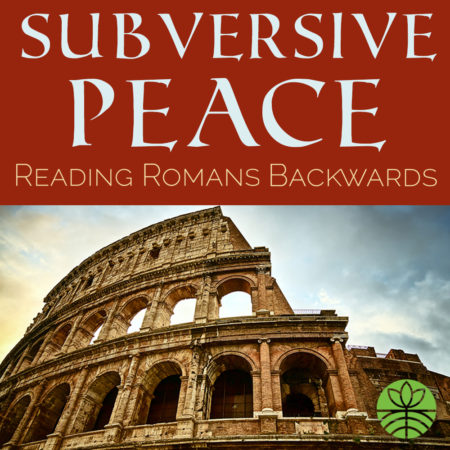
Romans isn’t a theoretical, systematic theology; it’s a letter written by the apostle Saul/Paul to a specific set of house churches in the city of Rome in the middle of the first century. Far too often, Romans has been taught as if its teaching can be abstracted from time and space. But that’s not how Romans is best understood. Instead, Romans is best understood as a loving, pastoral epistle to real people who were learning how to follow the Way of Jesus in a very specific social setting. In particular, Paul is writing to teach the disciples in Rome how to form a new kind of human community: the body of Christ—a community made up of misfits loved by God and united in the Lord Jesus Christ and the Holy Spirit. These house churches were highly diverse: they were made up of women and men, gentile disciples and Jewish disciples, slaves and socialites. Paul wants to teach them how to live together in peace as a subversive witness to the power of the Gospel in the shadow of the Roman empire. What could be more relevant to misfits like us, in a multiethnic and multicultural congregation, right here in the midst of the American empire?!
Reading Romans Backwards
 To prevent Romans from being thought of as abstract theology, it’s helpful to begin with the latter chapters where the letter’s social setting is addressed most explicitly. In the latter chapters of 12-16, the apostle Saul/Paul points to the way the house churches in Rome are called by God to live at peace with one another, even though they don’t share the same gender, culture, social status, or ethnicity. In chapters 14 and 15, Saul/Paul points out that among the disciples in Rome there are those who hold fast to the customs and markers of Jewish identity such as Torah-observance (e.g. keeping Sabbath, keeping kosher, and being circumcised) as essential for following the Way of Jesus. These disciples were mostly Jewish, and Saul/Paul calls them the “weak,” because their consciences are disturbed by the absence of Torah-observance among other disciples. The disciples among the churches of Rome who did not hold fast to markers of Jewish identity such as Torah-observance were mostly gentile disciples, even though Saul/Paul identifies himself among them. Saul/Paul calls this group the “strong.” In this series, we will see how the social setting of the diverse house churches is the context for the entire letter of Romans. And we will see how the Messiah and the Spirit create subversive peace in the body of Christ as a witness in the midst of empire.
To prevent Romans from being thought of as abstract theology, it’s helpful to begin with the latter chapters where the letter’s social setting is addressed most explicitly. In the latter chapters of 12-16, the apostle Saul/Paul points to the way the house churches in Rome are called by God to live at peace with one another, even though they don’t share the same gender, culture, social status, or ethnicity. In chapters 14 and 15, Saul/Paul points out that among the disciples in Rome there are those who hold fast to the customs and markers of Jewish identity such as Torah-observance (e.g. keeping Sabbath, keeping kosher, and being circumcised) as essential for following the Way of Jesus. These disciples were mostly Jewish, and Saul/Paul calls them the “weak,” because their consciences are disturbed by the absence of Torah-observance among other disciples. The disciples among the churches of Rome who did not hold fast to markers of Jewish identity such as Torah-observance were mostly gentile disciples, even though Saul/Paul identifies himself among them. Saul/Paul calls this group the “strong.” In this series, we will see how the social setting of the diverse house churches is the context for the entire letter of Romans. And we will see how the Messiah and the Spirit create subversive peace in the body of Christ as a witness in the midst of empire.
Roots’ Teaching Team

Roots is an intentionally multiethnic and multicultural community. This is also reflected in our Teaching Team, made up of Pastors T. C. and Osheta Moore, Pastor Der Lor, Emily Morrison, and Darin Mather. Just as the house churches in first-century Rome were culturally and ethnically diverse, we want our teaching to reflect the diverse perspectives of our congregation.


